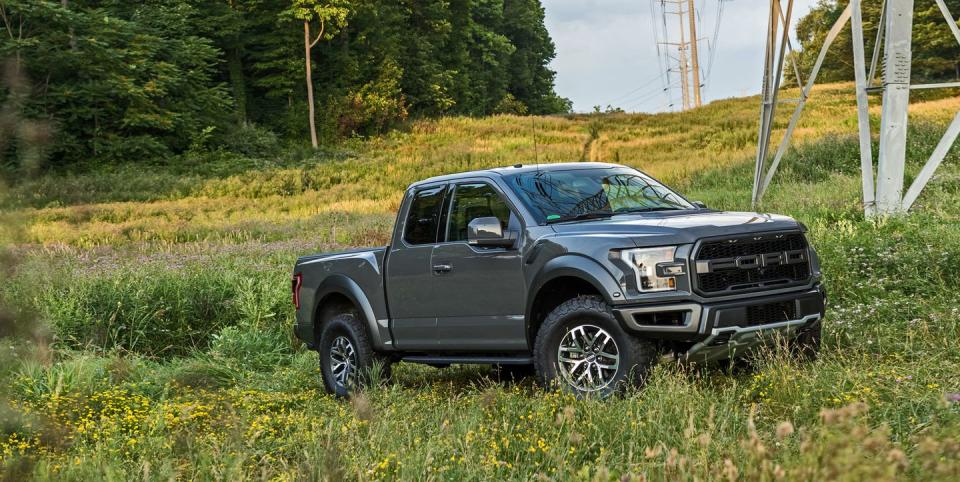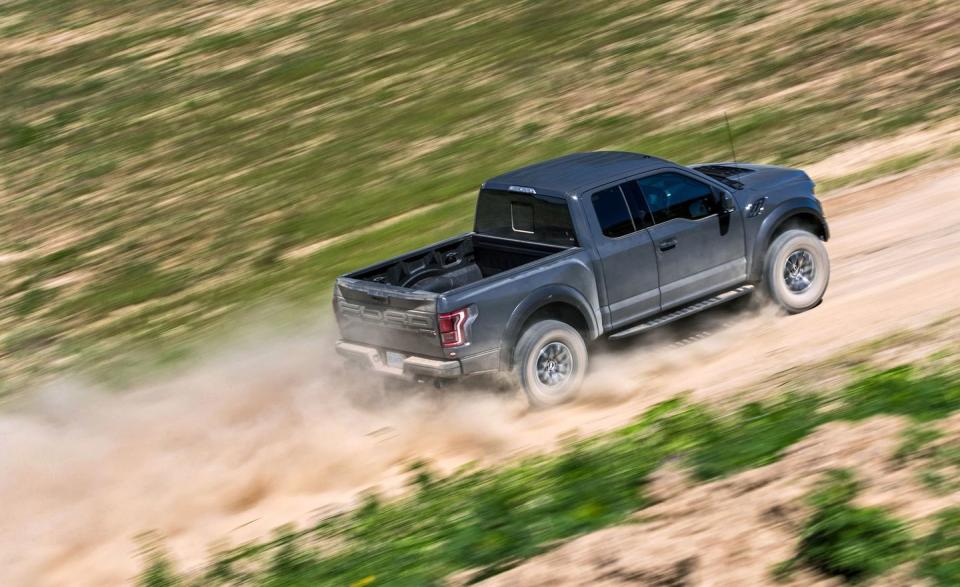Ford F-150 Raptor SuperCab's Shorter Wheelbase Makes It an Even Better Desert Racer

What It Is: Close your eyes and imagine a performance vehicle that weighs 5700 pounds, accelerates to 60 mph in 5.7 seconds, takes well over 200 feet to stop from 70 mph, and generates the same lateral grip as a Mercedes-Benz G550 4x4² SUV. Having trouble mashing those attributes into the mental image of something low, sexy, and fast-looking? Good, because the vehicle you should be thinking of is the F-150 Raptor on this page, which has none of those aesthetic traits. It is a blocky, off-road-ready F-150 variant that, unlike a Corvette, can leap speed bumps at highway speeds without spilling a drop from the coffee in its cupholder. This is the short-wheelbase extended-cab Raptor SuperCab, the version that looks most like a desert-racing Trophy Truck and thus is the coolest Raptor available-if also the least practical compared to the longer, even heavier crew-cab model.
Why We Tested It and How It Performed: We last tested a Raptor SuperCab in 2016 when the second-generation Raptor first debuted. We also tested a SuperCrew crew-cab model and put another SuperCrew through our 40,000-mile long-term test ringer. It left our fleet loved and missed, not least because it was the lone vehicle in our garage that was completely unfazed by southeast Michigan's cratered roads. Compared to that larger Raptor, the SuperCab model is nearly 200 pounds lighter and just under a foot shorter in length, making it slightly more maneuverable. This Raptor SuperCab proved notably slower than the atypically quick first one we tested back in 2016, taking 5.7 seconds to reach 60 mph, 0.7 second behind that 2017 model. In every non-acceleration-related metric, this 2018 Raptor SuperCab more or less matched its 2017 counterpart, along with the two SuperCrews we've tested.
What We Like: The Raptor seemingly was designed to star in YouTube videos-well considered and otherwise-in which it is captured jumping sand dunes, scrambling up hillsides, and otherwise being hooned around in the dirt. Ford ensured the Raptor could do these things, fitting wider bodywork than on regular F-150s, which makes room for wider-track suspension bits, Fox Racing dampers, and knobby BFGoodrich All-Terrain T/A KO2 off-road tires. The same hard-core suspension components that allow it to do crazy things off-road make it unbelievably comfortable and friendly on rough pavement. The rest of the package is normal F-150-save for the parking-space-filling girth those fenders add-meaning it's useful for Home Depot runs, towing, or tailgating. Plus, the Raptor just plain looks cool.
What We Don't Like: As awesome as the Raptor SuperCab looks, its rear bench seat can't match the SuperCrew's for stretch-out space. It's not bad, though the seatback is upright and rear-seat passengers won’t be able to cross their legs. And if you thought somehow that the bluff-shaped Raptor, with its muscular 450-hp twin-turbocharged V-6, might be fuel-efficient, think again. The tank holds 26.0 gallons, and you should get used to long, expensive, and frequent fill-ups. We averaged 14 mpg. In its standard drive mode, the Raptor's twin-turbo engine suffers some low-rpm lag that isn't helped by the 10-speed automatic transmission's waffling on gear selection. Using the more aggressive Sport mode helps alleviate the issue somewhat around town, but it's less efficient. Your fuel use may vary.
Pricing can also be an issue. The F-150 Raptor SuperCab tested here starts at a reasonable (given its performance and appeal) $55,110. Adding Equipment Group 802A-which brings a power-sliding rear window, the Sync 3 touchscreen infotainment system, blind-spot monitoring, automatic climate control, a heated steering wheel, an integrated trailer-brake controller, LED spotlights and bed lighting, remote engine starting, a B&O Play audio system, and a Torsen limited-slip front differential-inflates the price by $9770. With this truck's $495 spray-in bedliner, $375 tailgate step, $750 interior color accent package, and the $1950 Raptor Technology package, the grand total swelled to $68,495. That's a lot of dough just to play in the sand-or to look as though you play in the sand. But we won't judge.
Verdict: A truck like no other.
('You Might Also Like',)

 Yahoo Autos
Yahoo Autos 
